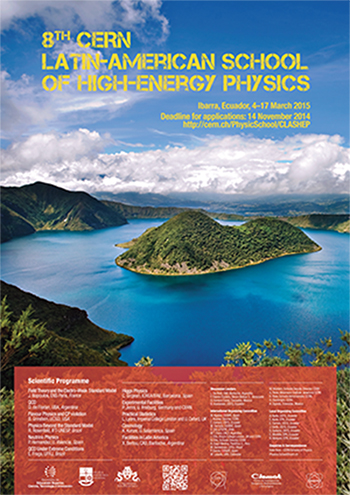CERN's Latin-American Schools of High Energy Physics
 The eighth CERN – Latin-American School of High-Energy Physics took place from 4 to 17 March 2015 in Ibarra, Ecuador. It was organized by CERN with the support of local colleagues from Escuela Politecnica Nacional (EPN), Quito, and Universidad San Francisco de Quito (USFQ).
The eighth CERN – Latin-American School of High-Energy Physics took place from 4 to 17 March 2015 in Ibarra, Ecuador. It was organized by CERN with the support of local colleagues from Escuela Politecnica Nacional (EPN), Quito, and Universidad San Francisco de Quito (USFQ).
The School was hosted in the beautiful and traditional Hacienda Chorlavi on the outskirts of the city of Ibarra. Edgar Carrera from USFQ, who is a member of the CMS collaboration, acted as local director for the School, assisted by members of the local organising committee.
Sixty-nine students of nineteen different nationalities attended the School. Following the tradition of the School, the students shared twin rooms mixing nationalities, and in particular the Europeans mixed with Latin Americans.
The eleven lecturers came from Europe, Latin America, and the USA. The lectures, which were given in English, were complemented by daily discussion sessions led by five physicists coming from Latin America. The students displayed their own research work in the form of posters in a special evening session during the first week. The posters were left on display until the end of the School. The students from each discussion group also performed a project, studying in detail the analysis of a published paper from an LHC experiment; a representative of each group presented a brief summary talk in a special evening session during the second week of the School.
The opening ceremony of the School was attended by high-level representatives of important organisations and universities in Ecuador. These included Rina Pazos, General Sub-Secretary of SENESCYT, Jaime Calderon, Rector of EPN, and Carlos Montufar, President of USFQ, all of whom addressed the participants, as well as Fernando Albericio, Rector of Yachay Tech University, and Daniel Larson, Chancellor of Yachay Tech University.

Group photo of participants at the School.
Hosting the School was an important event for the physics community in Ecuador and many outreach activities were arranged around it, benefiting from the presence of high-level scientists who were teaching at the School. In particular, a number of free public lectures were arranged in Quito and Yachay, and there was coverage in the local, regional, and national press.
In parallel with preparing and organising the School, there are on-going discussions in Ecuador involving SENESCYT, USFQ, and EPN towards possible national and institutional involvement in CMS, building on the existing participation at the level of individual researchers.

An Ecuadorian student answers a question during the Student Projects session.
In addition to the intensive scientific programme, there were three interesting excursions: an afternoon visit to the spectacular volcanic Cuicocha lake, and the towns of Otavalo and Cotacachi; a full-day excursion to the “Seven Waterfalls” reserve and the thermal springs at Chachimbiro; and a second afternoon excursion to the town of Ibarra followed by dinner at a restaurant with a beautiful panoramic view of the region.
More details about the 2015 Latin-American School may be found at: http://cern.ch/PhysicSchool/CLASHEP/CLASHEP2015
The 2015 CERN – JINR European School of Physics will be held in Bulgaria from 2 to 15 September, with a deadline for applications of 8 May.
The authors would also like to thank Kate Ross for her invaluable help and constant support in the organization of CERN's Summer Schools
